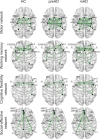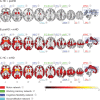Large-scale brain network abnormalities in Huntington's disease revealed by structural covariance
- PMID: 26453902
- PMCID: PMC6867397
- DOI: 10.1002/hbm.23014
Large-scale brain network abnormalities in Huntington's disease revealed by structural covariance
Abstract
Huntington's disease (HD) is a progressive neurodegenerative disorder that can be diagnosed with certainty decades before symptom onset. Studies using structural MRI have identified grey matter (GM) loss predominantly in the striatum, but also involving various cortical areas. So far, voxel-based morphometric studies have examined each brain region in isolation and are thus unable to assess the changes in the interrelation of brain regions. Here, we examined the structural covariance in GM volumes in pre-specified motor, working memory, cognitive flexibility, and social-affective networks in 99 patients with manifest HD (mHD), 106 presymptomatic gene mutation carriers (pre-HD), and 108 healthy controls (HC). After correction for global differences in brain volume, we found that increased GM volume in one region was associated with increased GM volume in another. When statistically comparing the groups, no differences between HC and pre-HD were observed, but increased positive correlations were evident for mHD, relative to pre-HD and HC. These findings could be explained by a HD-related neuronal loss heterogeneously affecting the examined network at the pre-HD stage, which starts to dominate structural covariance globally at the manifest stage. Follow-up analyses identified structural connections between frontoparietal motor regions to be linearly modified by disease burden score (DBS). Moderator effects of disease load burden became significant at a DBS level typically associated with the onset of unequivocal HD motor signs. Together with existing findings from functional connectivity analyses, our data indicates a critical role of these frontoparietal regions for the onset of HD motor signs.
Keywords: Huntington's disease; MRI; Pearson's correlation; functional networks; grey matter volume; structural covariance.
© 2015 Wiley Periodicals, Inc.
Figures




References
Publication types
MeSH terms
Grants and funding
LinkOut - more resources
Full Text Sources
Other Literature Sources
Medical

